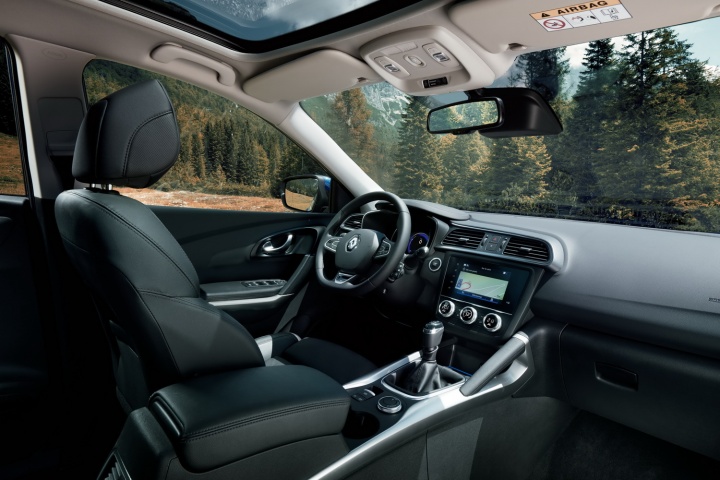What's the news?
The Renault Kadjar C-segment SUV has been around for three years now, so it's time for a round of technical updates and a notable facelift as part of the model's midlife refresher course.
The big changes come at the front, where the Kadjar has less of a beaky look and a face which more closely matches in to those of its larger Koleos and smaller, recently refresh Captur crossover/SUV stablemates. That means the Kadjar now employs a wider grille, larger headlamps with a C-shaped signature, and front LED foglights and indicators. At the back, all of the indicators, reversing lights and foglamps are now LED, as well as having slightly slimmer units built into the bumper.
Top models of Kadjar will enjoy a shark-fin antenna, while there are two new types of 17- and 19-inch alloy wheels, along with three fresh colours - Iron Blue, Highland Grey and Oural Green, this last one being the French word for the Ural Mountains of Russia. Inside, the dashboard has a more neatly integrated seven-inch screen for the R-Link 2 infotainment, the air-conditioning/climate system has a redesigned set of controls, satin chrome is used for much of the brightwork, new colours/upholsteries/stitching are available and there have been some useful changes to comfort and practicality.
The front seats are said to be more ergonomic, with length adjustment and double-density foam inners, while the rear door cards have been reshaped to give more elbow room, a neater placement of switches and door bins that can take a large bottle of water; similarly, the front door bins can hold 1.5-litre items. Further additions include a pair of larger central cupholders in the console, lighting in the cubby ahead of the gearlever, two USB sockets in the rear and puddle lamps in the door mirrors.
Under the bonnet, the Kadjar gains new-gen engines. For the petrol models, the old 1.2-litre unit has been junked in favour of a 1.3-litre TCe GPF motor, that is actually co-developed between Renault-Nissan Alliance and Daimler-Benz, as it's the same powerplant as found in the updated Mercedes A-Class. Already in use in the Captur and Megane siblings, for the Kadjar this four-pot motor comes in 140- and 160hp guises, with a choice of manual or EDC twin-clutch gearboxes, making for a quarter of derivatives.
Meanwhile, the diesel engines will now go under the name 'Blue dCi', as they feature selective catalytic reduction to cut down on NOx exhaust gases. And they're up on power/torque, too, as the former 110- and 130hp choices have been increased to the Blue dCi 115hp (also with an additional 10Nm of torque, for 270Nm overall) and the Blue dCi 150hp. Both motors gain the manual gearbox, with the EDC coming later on the 115hp version, while the more powerful engine is available with either 4x2 or 4x4 configurations.
Anything else?
Olivier Tschanhenz, the deputy marketing director for Renault, said: "Launched in 2015, Kadjar is a core vehicle in the Renault range, a global model already chosen by more than 450,000 customers in over fifty countries. New Kadjar will consolidate this position through a more modern, stylish design, improved comfort and better perceived quality. At the same time, it will build on its 4WD offering, since this sets it apart in the market."









